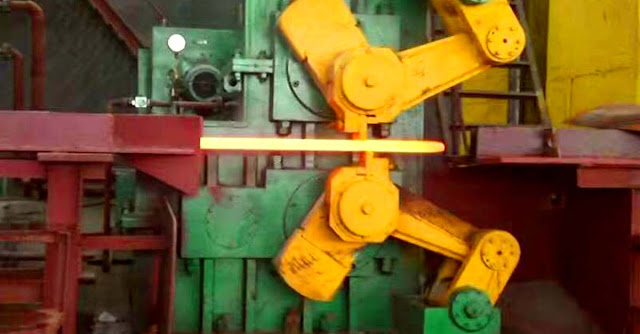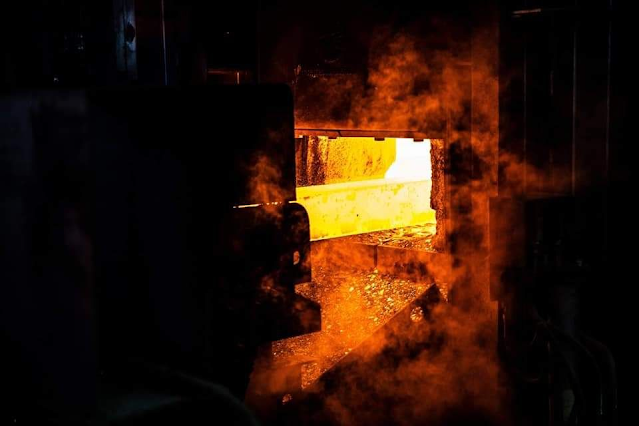High-speed steel can be divided into traditional casting technology, electro slag remelting technology, powder metallurgy technology, and spray molding technology according to different preparation processes. Among them, traditional high-speed steel can be divided into ordinary high-speed steel, high-performance high-speed steel and low alloy high-speed steel. As a high alloy ledeburite steel, the carbon content of high-speed steel can exceed 1%, and the type, quantity, size, and distribution of carbides are the key factors to determine its properties. Therefore, different preparation processes have an important impact on the properties of high-speed steel.
Traditional Manufacturing Technology
Overview: the traditional casting process of high-speed steel is simple and low cost. However, due to its slow solidification rate, a large amount of carbon and alloy elements segregate before crystallization, thus forming an intercrystalline carbide network. In order to eliminate the uneven distribution of carbides, high-temperature repeated forging or rolling is used to break them and distribute them evenly. However, this forging process is easy to cause cracking and is limited by the processing equipment and forging press ratio, resulting in the utilization rate of high-speed steel from ingot to final product in the whole process is only 24% - 36%.
Disadvantages: the high-speed steel prepared by the traditional casting process is prone to stress concentration, large brittleness, poor toughness and low yield during use.
Electroslag Remelting Technology
Overview: electro slag remelting technology is a refining metallurgical technology. It is major metallurgical technology progress, especially in improving the macrostructure of high-speed steel and improving the quality of steel. It is a comprehensive metallurgical casting process combining secondary refining and directional solidification of molten steel. Through this method, the sulfur and phosphorus content of molten steel can be reduced, the purity of molten steel can be improved, and the macrostructure of steel can be improved. Because the cooling speed of electroslag ingot is faster, the carbide distribution in the steel is more uniform, and the improvement of the microstructure also improves the thermoplasticity of the high-speed steel.
Disadvantages: Despite all kinds of progress and advantages, electro slag remelting solidification speed is still low, grain size is still relatively large, carbide size distribution is still uneven, and its energy consumption is high, production efficiency is low, fluoride is produced in the production process, which is harmful to the environment and human body.
Powder Metallurgy Technology
Summary: In 1965, the Crucible Steels of the US invented the powder metallurgy method to produce high-speed steel. The production process is mainly divided into two steps:
1. The basic principle of gas atomization is that the molten high-speed steel flows out at a certain flow rate after being restricted by the guide pipe at the bottom of the crucible, and is atomized into a powder with a certain size distribution by high-pressure argon or pure nitrogen.
2. Powder molding: after screening and pre-pressing, it is hot isostatic consolidated and densified under high temperature (1100 ℃) and high pressure (100MPa) to form a near-finished blank, or it is first prepared into a steel blank and then machined into the final shape. This process effectively solves the problem of coarse carbide eutectic segregation in the ingot when melting high-speed steel, and obtains fine and uniform crystal structure.
Advantages: the microstructure of powder metallurgy high-speed steel is fine, and its strength and toughness are 2 times and 2.5-3 times that of smelting high-speed steel respectively; High strength, good dimensional stability after heat treatment, good processability, high hardness and good wear resistance. The high-temperature thermal hardness is also higher than that of melted high-speed steel by hrc1-2, the physical and mechanical properties are highly isotropic, and the quenching deformation is small; Wear resistance increased by 20% ~ 30%; High heat treatment yield and good economic benefit; It has good formability and has great advantages in preparing precision and complex props.
Disadvantages: the production process of powder high-speed steel is too cumbersome and the process is long. Generally, it needs to go through milling screening pressing sintering, with the high cost and high price; In addition, it also has the problems of the complex preparation process, serious powder oxidation, and difficulty to prepare large billets.
Spray Molding Technology
Overview: spray molding was proposed by Professor A. Singer of Swansea University in England in 1968, and was developed by R. Brooks and others have successfully applied it to the production of forging blanks and developed the famous Osprey process, which is an advanced technology for preparing high-performance materials by rapid solidification. Spray forming high-speed steel also belongs to powder metallurgy high-speed steel. This technology eliminates the macro segregation of components and has the structural characteristics of powder metallurgy.
Advantages: spray forming process is a metallurgical technology that combines the advantages of traditional casting and powder metallurgy. The details are as follows:
(1) The tissue is fine and uniform;
(2) The spray forming process allows more impurity elements than the conventional process;
(3) Short process flow, high yield and low cost;
(4) Low oxidation degree
Disadvantages: there is always a certain amount of porosity in the deposited blank, but the complete chamber can usually be achieved by extrusion, hot cold rolling or hot isostatic pressing, and the final product efficiency is obviously lower than 100%; The material loss comes from: 1. Overspray of molten droplets 2. The molten droplets or particles bounce off the surface of the blank 3. Detection of scrap or processing loss and removal of the substrate and top of the blank 4. Scrap of metallurgical quality problems.
The process flow of metal powder spray molding is: the atomization of metal liquid - high-speed flight of liquid droplets - collision deformation and solidification of liquid droplets with a precipitator or mold. That is, the powder is first heated into a molten metal liquid and then gas atomized; Under the action of the gas jet, the droplet accelerates its flight and cools rapidly; When the high-speed flying droplets collide in the precipitator, the spherical particles become flat under the impact and form a sputtering sheet; Through the cooling effect of the precipitator, the particles are rapidly solidified and accumulated under the self fusibility.
Looking for any kind of metallurgy equipment, please feel free to contact me.
Email: marketing2@hanrm.com; kerrirollingmill@gmail.com.
WhatsApp & WeChat: +8618392033938.
Website: www.hanrm.com.






